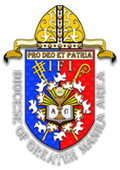The Icon of Birhen Balintawak
By: The Rev. Fr. Mario Varona, PhD*
This is an image of the Blessed Virgin Mary dressed in the traditional balintawak, leading a handsome boy in a peasant garb who is armed with a bolo like a katipunero. On this statue is an inscription, “Ama ko, sumilang nawa ang aming pagsasarili.”
This is a unique image because when contextualized in the period of the Spanish colonialism and American imperialism, this image expresses subversion. The classical meek child Jesus is transformed into a militant lad, and Mary into “Inang Bayan” (Motherland). To those who are steeped in the traditional Catholic devotion, the image diverges from the traditional mold characterized by the European aristocratic countenance. This image rather emphasizes what is marginal in terms of race and status: Indio, peasant, katipunero – marginalized from the social circle and considered aberrations in society during the Spanish and early American colonial periods. Undoubtedly, the image expresses the combined emotion inherent in the religious and nationalist ideals of “Pro Deo et Patria”: Religion is reflected by the Blessed Virgin Mary while the country by the katipunero’s aspirations for independence.
The 1905 Calendario de la Iglesia Filipina Independiente marked August 26 very boldly as “Pista ng Kalayaan”. Visible during the celebration was the “Birhen Balintawak,” while the most emotionally-filled phase was the chanting of the prayer for the “veteranos de la revolucion” (veterans of the revolution). With the Holy Mass celebrated in the vicinity of the statue of Bonifacio in Balintawak (Caloocan), who would not cry for God and country? The Bonifacio statue has now been transferred to U.P. Diliman Campus and in its place an imposing monument of Bonifacio sculptured by Guillermo Tolentino was erected. Bishop Gregorio Aglipay blessed this impressive monument in 1933 before he left for Switzerland.
 Today the wooden statue of the Birhen Balintawak is enthroned in the Maria Clara Church, another symbolic name in honor of the heroine in Rizal’s Noli Me Tangere. By placing it there all the more signifies an all-powerful aspiration to be truly free from foreign domination. The church is located on V. Concepcion Street, Santa Cruz, Manila, and is adjacent to the old ancestral house of Don Isabelo delos Reyes Sr.
Today the wooden statue of the Birhen Balintawak is enthroned in the Maria Clara Church, another symbolic name in honor of the heroine in Rizal’s Noli Me Tangere. By placing it there all the more signifies an all-powerful aspiration to be truly free from foreign domination. The church is located on V. Concepcion Street, Santa Cruz, Manila, and is adjacent to the old ancestral house of Don Isabelo delos Reyes Sr.
An interview with the diocesan bishop of Metro Manila, the Rt. Rev. Gregorio delos Reyes, informed the researcher that an annual fiesta was dedicated to the Birhen Balintawak. The fiesta used to be every August 26 but moved to May 1 starting 1923 coinciding with the Labor Day inasmuch as the beginnings of the Church (Iglesia Filipina Independiente) intertwined with the first labor union. The good bishop remembered that in the prewar years hundreds of devotees from Tondo, Tatalon, and even from Malabon and Pandacan came for the fiesta. During those years the Sampaloc area was like a rural village where people were knit together as a community. Bound by traditions, the joyous celebration was feted with bands and a long procession. However, when Aling Veronica Crisostomo, the hermana mayor whose responsibility included “pagpapalit ng damit ng Birhen” transferred residence to Cavite and died, the annual celebration gradually began to wane. The good bishop could also remember that a certain old man, Mr. Mejia, a katipunero from Tondo, used to lead the novena of the Birhen Balintawak.
According to Aurelio Tolentino, a katipunero himself, in his article that appeared in the newspaper La Vanguardia sometime before his death in 1915, a certain katipunero dreamed of the Birhen Balintawak on the night before the discovery of the Katipunann in August, 1896. Tolentino described the event clearly:
“… One night as Andres Bonifacio, Emilio Aguinaldo, himself and others were asleep in Tandang Sora’s house in Balintawak, one of them dreamed of a beautiful woman leading by the hand a handsome child. The woman looked exactly like the Virgin Mary in church statues, except that she wore a native costume, the balintawak. The child was dressed in peasant garb, armed with a glittering bolo, and shouting, “Kalayaan”. The woman approached the dreamer to warn him about something. Roused from his sleep, he narrated his dream to his companions and who all concluded that the Virgin Mary was warning them against proceeding to Manila that morning. They decided to tarry a while longer in Balintawak. Later the news arrived that the Katipunan-infiltrated printing shop of Diario de Manila had been raided by the guardia civil. Without the Virgin’s warning, Bonifacio would have been captured along with the others and executed, and the revolution delayed indefinitely.” Inspired by this prophetic dream, Bishop Aglipay wrote the novenario, “Pagsisiyam sa Birhen Balintawak: Ang Birhen Balintawak ay ang Inang Bayan” (9 Days of Novena for the Virgin of Balintawak: The Virgin of Balintawak is the Motherland).
(*Excerpt from Fr. Verona’s article, “Ang Birhen Balintawak ay ang Inang Bayan: An Interpretive Study,” courtesy of the IFI Historical Society, Inc; reprinted from “Ang Tagapunla, IFI, July 2002.)


